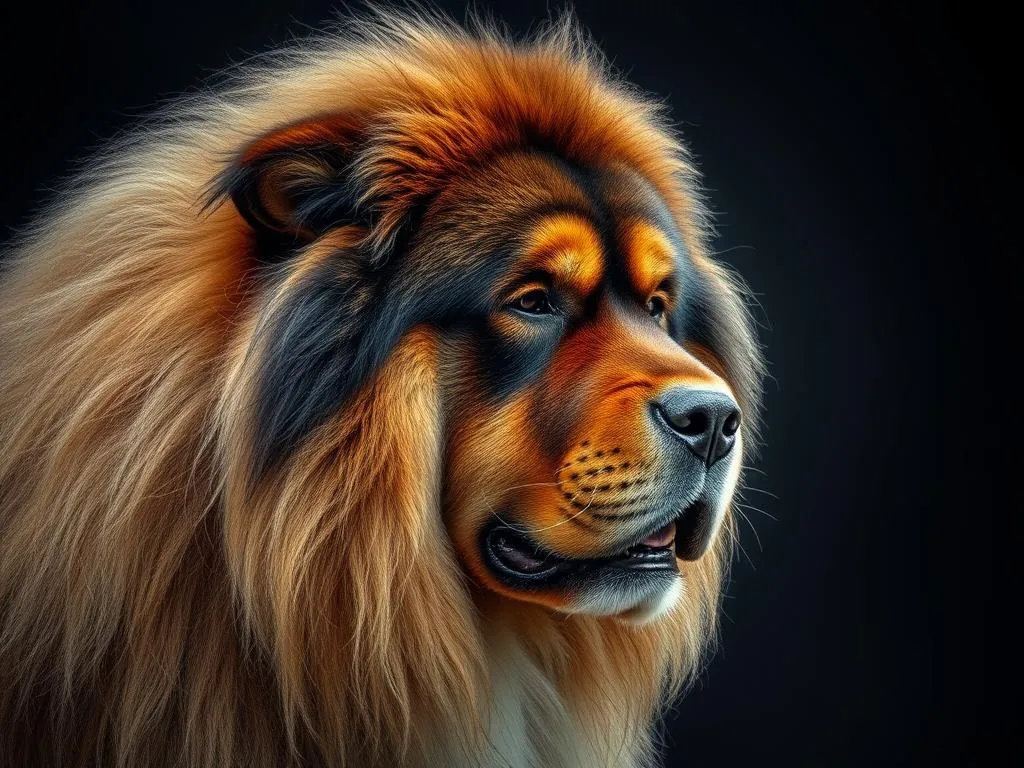
Introduction
The Tibetan Mastiff is a majestic and imposing breed known for its stunning appearance and strong personality. Originally bred as a guardian dog in the Himalayan region, this breed has garnered attention not only for its striking features but also for its unique temperament. Understanding the Tibetan Mastiff pros and cons is crucial for anyone considering adding this breed to their family. This article aims to provide a balanced view of living with a Tibetan Mastiff, helping potential owners make an informed decision.
History and Background of Tibetan Mastiffs
The history of the Tibetan Mastiff is rich and steeped in tradition. This breed dates back thousands of years and is believed to have descended from ancient mastiff-type dogs that accompanied nomadic tribes in Tibet, China, and India. Historically, Tibetan Mastiffs were bred to protect livestock from predators such as wolves and leopards. They also served as guardians of monasteries and villages, showcasing their loyalty and bravery.
In Tibetan culture, these dogs were highly revered and often considered sacred due to their protective instincts and strong presence. Over time, the breed evolved, adapting to various climates and environments, but its fundamental characteristics—strength, loyalty, and a protective nature—have remained intact.
Physical Characteristics
Size and Weight
Tibetan Mastiffs are large, powerful dogs. Adult males typically stand between 26 to 30 inches tall at the shoulder, while females range from 24 to 28 inches. In terms of weight, males usually weigh between 90 to 150 pounds, whereas females weigh between 70 to 120 pounds. Their size alone can be intimidating, making them excellent guardians.
Coat and Color Variations
One of the most striking features of the Tibetan Mastiff is its luxurious coat. They have a thick, double-layered fur that helps them withstand cold climates. The most common colors include black, brown, and gold, but they can also exhibit various combinations and markings. The mane-like fur around their neck and shoulders gives them a lion-like appearance, further enhancing their regal look.
Unique Physical Traits
In addition to their impressive stature, Tibetan Mastiffs possess unique physical traits. Their powerful build, strong bones, and muscular frame contribute to their overall strength. Their broad heads, deep-set eyes, and distinct facial expressions exude confidence and protectiveness.
Temperament and Behavior
General Personality Traits
The Tibetan Mastiff is known for its complex personality. They are incredibly loyal to their families and can be quite affectionate with those they trust. However, they also have an independent streak and may exhibit stubbornness, which can pose challenges for novice dog owners. Their protective nature often leads them to be wary of strangers, making them excellent watchdogs.
Interaction with Families and Children
While Tibetan Mastiffs can be great companions for families, it’s essential to approach their interactions with children thoughtfully. They are generally good with kids, especially if raised with them from a young age, but supervision is crucial. Their large size may unintentionally intimidate small children, and they may not tolerate rough handling.
Socialization Needs
Early socialization is vital for a Tibetan Mastiff. Introducing them to various environments, people, and other animals can help them develop into well-rounded adults. Without proper socialization, they may become overly protective or aggressive toward unfamiliar situations.
Barking Tendencies
Tibetan Mastiffs have a reputation for being vocal. They often bark to alert their owners of any perceived threats or disturbances. While this trait can be beneficial for security, excessive barking can become an issue if not managed correctly. Training and consistent reinforcement of acceptable behavior can help mitigate this tendency.
Pros of Owning a Tibetan Mastiff
Protective Nature
One of the most significant advantages of owning a Tibetan Mastiff is their protective instincts. They are natural guardians who are fiercely loyal to their families. This breed will go to great lengths to protect their loved ones, making them an excellent choice for those seeking a vigilant companion.
Low Maintenance Grooming
Despite their thick coats, Tibetan Mastiffs have relatively low grooming needs. Their double coat sheds seasonally, which means regular brushing during shedding seasons will suffice. However, they do not require frequent baths unless they get particularly dirty, making them easier to care for compared to other breeds.
Unique Appearance
The Tibetan Mastiff is undeniably striking. Their size, mane-like fur, and unique color variations set them apart from other breeds. Many people are drawn to their majestic presence, which can make them a talking point in social settings.
Calm Demeanor
Compared to other large breeds, Tibetan Mastiffs tend to have a calm demeanor. They are not hyperactive and often prefer a more laid-back lifestyle. This characteristic makes them suitable for families who appreciate a more relaxed companion.
Longevity and Health
Tibetan Mastiffs typically have a lifespan of 10 to 14 years. While they are generally healthy, certain health issues can arise, such as hip dysplasia and certain eye conditions. Regular vet check-ups and a healthy diet can contribute to their longevity and overall well-being.
Cons of Owning a Tibetan Mastiff
Space Requirements
One of the primary Tibetan Mastiff cons is their need for space. These dogs thrive in environments where they have room to roam and play. They are not well-suited for apartment living or homes without a secure yard. Ideally, they need a large, fenced area to expend their energy.
Strong-Willed Nature
Tibetan Mastiffs have a strong-willed personality, which can pose challenges during training. They may resist commands and require an owner who is experienced and confident. Consistent training and positive reinforcement methods are essential to ensure they understand expectations.
High Exercise Needs
While they have a calm demeanor, Tibetan Mastiffs still require regular exercise to maintain their health and happiness. Daily walks and playtime are essential, especially during their younger years. If their energy needs are not met, they may develop behavioral issues.
Potential Health Issues
Like any breed, Tibetan Mastiffs can be prone to certain health problems. Common issues include hip dysplasia, hypothyroidism, and certain skin conditions. Potential owners should be prepared for the possibility of unexpected veterinary expenses and should choose a reputable breeder who conducts health screenings.
Cost of Ownership
Owning a Tibetan Mastiff can be expensive. The initial purchase price can range significantly depending on the breeder, but ongoing costs such as high-quality food, regular vet visits, grooming supplies, and training classes should also be considered. Potential owners must be financially prepared for the responsibilities of dog ownership.
Ideal Living Conditions
Best Environments for a Tibetan Mastiff
The ideal living environment for a Tibetan Mastiff is spacious and secure. Rural or suburban settings with ample outdoor space are preferable. They can adapt to various climates, but they thrive in cooler temperatures due to their thick coats.
Recommendations for Potential Owners
Potential owners should ensure they have adequate living arrangements for a Tibetan Mastiff. A securely fenced yard is essential, as these dogs may wander if they feel bored or restless. Additionally, individuals or families with active lifestyles will find that this breed can be a great match, provided they can meet their exercise needs.
Training and Socialization Tips
Importance of Early Training
Starting training early is crucial for Tibetan Mastiffs. Early obedience training can help shape their behavior and strengthen the bond between dog and owner. It also sets the groundwork for a well-mannered adult dog.
Techniques for Effective Training
Using positive reinforcement techniques is the most effective way to train a Tibetan Mastiff. Rewarding good behavior with treats, praise, and playtime encourages them to repeat those actions. Avoid harsh training methods, as they can lead to fear or aggression.
Socialization with Other Pets and People
Socializing your Tibetan Mastiff with various pets and people is essential. Introduce them to different environments, sounds, and experiences gradually to help them become comfortable and reduce anxiety or aggression toward unfamiliar situations.
Handling Stubbornness and Behavioral Issues
If your Tibetan Mastiff exhibits stubbornness, patience is key. Consistent training, combined with understanding their independent nature, will yield the best results. If behavioral issues arise, consulting a professional trainer who has experience with large breeds can be beneficial.
Conclusion
In summary, the Tibetan Mastiff is a breed with both distinct advantages and notable challenges. Their protective nature, unique appearance, and calm demeanor make them appealing to many potential owners. However, understanding the space requirements, strong-willed nature, and potential health issues is crucial.
Before adopting a Tibetan Mastiff, it’s important to thoroughly assess your lifestyle and living conditions. This breed requires dedication, patience, and a commitment to their care and training. Those who do their research and are prepared for the responsibilities of ownership will find a loyal and loving companion in a Tibetan Mastiff.









